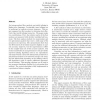Free Online Productivity Tools
i2Speak
i2Symbol
i2OCR
iTex2Img
iWeb2Print
iWeb2Shot
i2Type
iPdf2Split
iPdf2Merge
i2Bopomofo
i2Arabic
i2Style
i2Image
i2PDF
iLatex2Rtf
Sci2ools
ICFP
1997
ACM
1997
ACM
The Effectiveness of Flow Analysis for Inlining
An interprocedural flow analysis can justify inlining in higher-order languages. In principle, more inlining can be performed as analysis accuracy improves. This paper compares four flow analyses to determine how effectively they justify inlining in practice. The paper makes two contributions. First, the relative merits of the flow analyses are measured with all other variables held constant. The four analyses include two monovariant and two polyvariant analyses that cover a wide range of the accuracy/cost spectrum. Our measurements show that the effectiveness of the inliner improves slightly as analysis accuracy improves, but the improvement is offset by the compile-time cost of the accurate analyses. The second contribution is an improvement to the previously reported inlining algorithm used in our experiments. The improvement causes flow information provided by a polyvariant analysis to be selectively merged. By merging flow information depending on the inlining context, the algori...
| Added | 26 Aug 2010 |
| Updated | 26 Aug 2010 |
| Type | Conference |
| Year | 1997 |
| Where | ICFP |
| Authors | J. Michael Ashley |
Comments (0)

